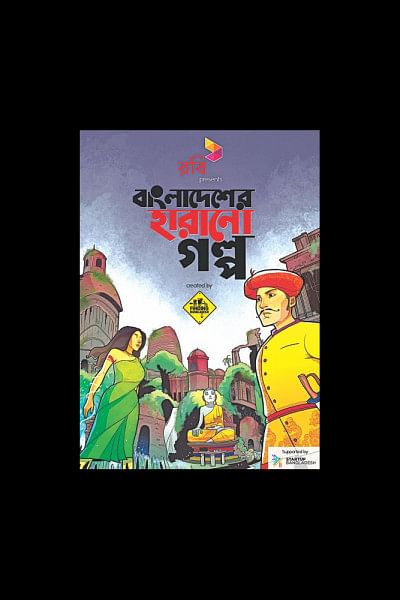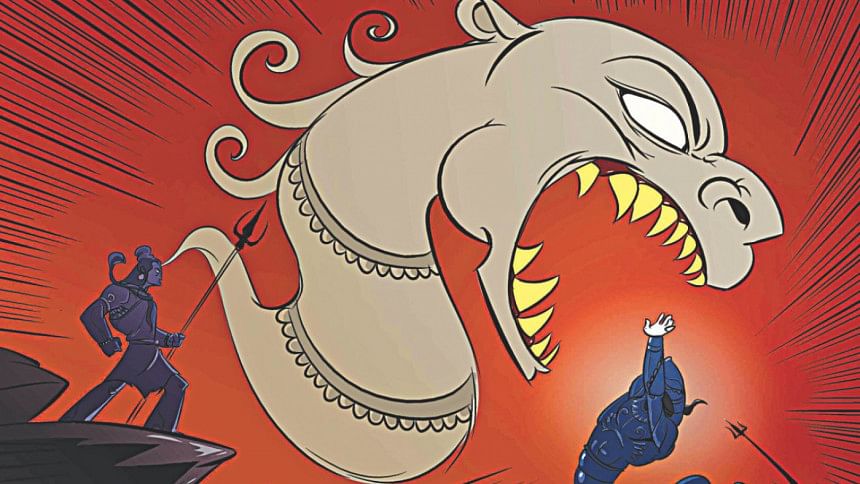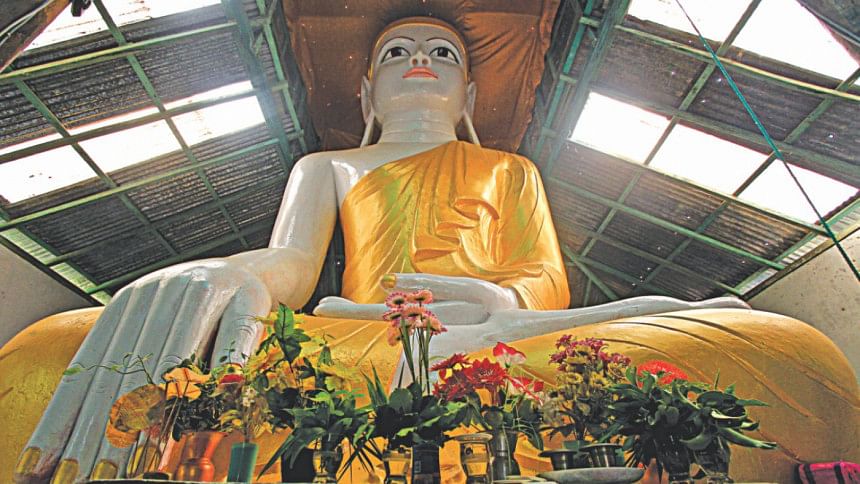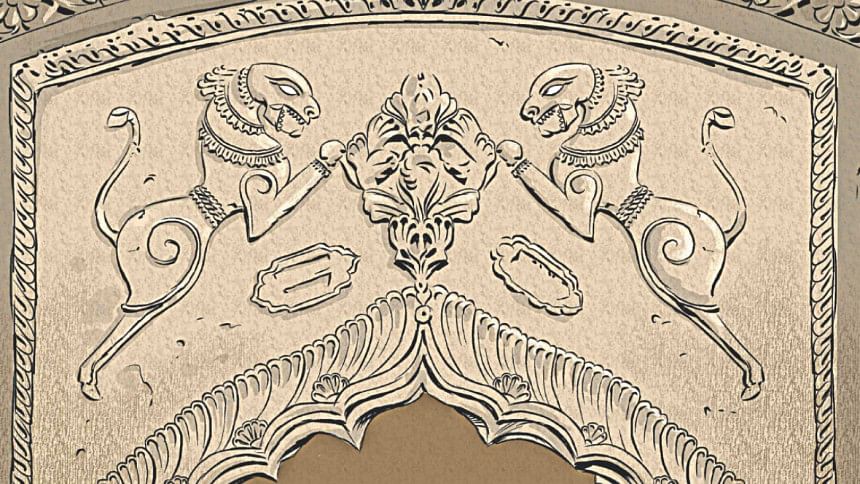The Quest for Finding Bangladesh

Scotland has its Loch Ness, China, its assortment of dragons, and India, a whole consort of mythological beings that have delved into their culture and identity. What do we have from our ancient histories that form an integral part of our identify? I did not have an answer, and this is the question that lead me to initiate Finding Bangladesh.

Finding Bangladesh is a quest of a group of young people which focuses on collecting, preserving and initiating conversations on Bangladesh's ancient histories, mythologies and legends. The aim is to revive lost tales of our land and help us in being more sentient of ourselves—our identity. Many in our younger generations have grown up studying post-colonial political and western histories, Roman legends and Greek mythologies—but what about stories of our own?
We have a rich heritage that we should be proud of; terrific mysteries of man and monster, majestic monuments and wonders. We couldn't bear seeing the historical sites gradually decaying due to lack of preservation and their magnificent stories being lost forever. Finding Bangladesh's latest documentary film attempts to immortalise the tales and historical sites. If anything, the documentary is intended to inspire you to go out yourself, explore and know more about our country.
Finding Bangladesh's most recent film, Bangladesh er Harano Golpo, directed by me, presented by Robi Axiata Ltd. and supported by Startup Bangladesh, premiered on October 26 and focuses on forgotten tales from the Barishal and Khulna regions. The 80-minute-long documentary film portrays 11 stories from 17 historical locations across the south of Bangladesh.
The brilliant saga of Raja Pratapaditya, one of the legendary Baro Bhuiyans, the journeys of Khan Jahan Ali, the legends of Gazi, Kalu, Chompaboti, and the mythologies of the Makara, Bon Bibi and Kamini are covered in this film. Stories from Jashore's Jora Shiv Temples and the Abhayanagar 11-Shiv Temples, Shyamnagar's Ishwaripur Rajbari and Damrail Navaratna Temple, Bagerhat's Ajodhya Temple and the Shat Gombuj Mosque, Baro Bazaar, Dhopadi Temple, Pirojpur's Rayerkathi Palace and Temples, the ghost stories of Krittipasha Palace, and Kuakata's Misri Para Buddha Vihara are also featured.
While it makes little sense just listing the stories, in this In Focus, I attempt to give you a quick overview of three of the stories covered in the film.

The Makara and the Lion
Humans have a tendency to worship what they fear. And it is from this fear that the story begins. Back during the Indus Valley civilisation in 3,300 BC when boats were the main transportation, enormous crocodiles used to attack the boats making travelling very risky. People feared the crocodiles and started to worship them for safe passage.
This fear began the mythology of the Makara—the oldest known image of the creature has been found as a wood carving on the mast of a boat. Over the years Makara seeped into religion; into Buddhist manuscripts, bearing the icon of ceremonial daggers, and Hindu mythologies, becoming the river goddess Ganga and sea god Varuna's preferred mode of transportation. Interestingly, small carvings of the Makara were also found as decoration in a mosque in Kishoreganj.
The English word "dragon" derives from Greek drákōn, literally meaning a "large water-snake or serpent" and the Makara is described as being one of the earliest forms of a dragon making its home in the Bay of Bengal. The Makara has clearly crossed religious boundaries and has been a hidden part of our land's culture for centuries, yet no one seems to know about it.
Bangladesh is populated with remains of the Makara. Sonargaon's Panam Nagar, Pirojpur's Rayerkathi Temple, Bagerhat's Ajodhya Math and Jashore's Jora Shiv Temples all house the creature. Makara takes an interesting shape in Bangladesh; with the teeth of a crocodile, the head of an elephant and the body of a dolphin, this beast is said to be over 100 miles long. The local name the makara is mokkor and the constellation Capricorn is also based on this creature.
Interestingly two lions jumping towards a fruit tree always seem to accompany the Makara, especially in Shiv Temples. The lion has its own interesting story.
As the tale goes, when Shiv, was about to wed Parvati, a messenger named Rahu came to him from the land of demons. The message he brought was that the Demon Lord considered Shiv unworthy to wed Parvati, and that he himself would take her instead. Shiv became so angry that a monster in the shape of a man-lion sprang out from between his eyes and fell upon the unfortunate Rahu. Rahu begged for mercy. Shiv agreed to let him go but the lion that was born of his wrath complained of hunger.
"You created me to devour the demon," he protested. "And now you have forgiven him and sent him away. What am I to do?"
"If you have been cheated of one demon," replied Shiv, "there is still another. You will just have to eat yourself."
And this the monster did. He devoured himself until nothing remained of him but the face. The sight of this so amused Shiv that he appointed the lion spirit as guardian of his door alongside the makara; to be worshiped and fed by all who entered.

The tale of Princess Abhaya
The second story lies in the deepest, muddiest and darkest roads of Jashore, right at the heart of Abhaynagar upazila, in a village called Bhatpara. Therein is a beautiful temple complex consisting of 11 temples dedicated to Lord Shiv. Although the temples are in a dilapidated state today, one can easily comprehend their grandeur—they were once adorned with beautiful terracotta plaques. Under the orders of Raja Nilkontho Rai, his dewan, Horiram Mitra, had built the 11 temples, as a dedication to Lord Shiv, between 1745 and 1764.
There is an interesting mythology connected to the construction of the 11 temples. According to the myth, the Raja did not have any children and had prayed to Shiv for a daughter. The Raja promised that if his wishes were fulfilled, he would wed his daughter to the God. Shiv heard the Raja's calling and soon the Raja had a daughter. The daughter was named, "Abhaya" and from her came the name of the region, "Abhayanagar." Bearing his promise in mind, the Raja wed his daughter to Shiv and the 11 temples were built as temple-house for newly wedded couple. The story goes that Abhaya spent her days in the temple-house praying to Shiv and taking care of the structures, hoping to one day be reunited with him. It is in honour of princess Abhaya, that the region is named Abhayanagar.
Now what is interesting is that the British Demographic Surveys from late 1800s document local stories of a widowed woman who took shelter in the temples. She led her entire life in the temples, voluntarily taking care of them and of the people who came for prayers. So naturally questions are raised: was princess Abhaya just a myth or was the widowed women's story transformed to the princess. I guess that is an answer we will never know.

The Goddess of the Sundarbans
Every year in April, before wood cutters and honey hunters step into the Sundarbans, they have a huge gathering whether they perform rituals and pray to "the lady of the forest." What is interesting though is that Hindu, Buddhists and Muslims alike, all pray to this deity, regardless of religion or caste. They pray for protection from the perils of the forest and believe this "lady of the forest" will be able to grant them that.
The lady of the forest is Bon Bibi. Lore has it that Bon Bibi was chosen by divine powers to protect and help the people who sought her aid in the forest. When Bon Bibi arrived at the Sundarbans along with her brother, Shah Jungalee, it was being ruled by Dakkhin Ray, a self-proclaimed tiger-demon lord who apparently loved to eat human flesh. In an epic battle, Bon Bibi had overthrown Dakkhin Ray and out of sheer goodness, she refrained from banishing the demon entirely. Dakkhin Ray was allowed to rule a small island called Kedokhali in the Sundarbans under the condition that he would not to hurt anyone. Sadly, old habits die hard.
Two mowalis or honey collectors by the name of Dhona and Dukhe were searching desperately for honey but could find none. They eventually ventured into Kedokhali. Dakkhin Ray saw them and made a proposition to Dhona in his dream. He proposed that if Dhona would be willing to sacrifice Dukhe, then Dakkhin Ray would fill all of their empty boats with honey. Overwhelmed with greed, Dhona accepted. Dukhe was about to be devoured by Dakkhin Ray and prayed to Bon Bibi for protection. Bon Bibi became furious was prepared to unleash her deific wrath upon Dakkhin Ray when he exclaimed that if humans like these honey-collectors are granted the liberty to enter the forests without any rules or regulations then they would destroy the land. The flesh eating, tiger-demon tyrant had made a good point. Shame on us.
Bon Bibi heeded Dakkhin Ray's concern and to protect the forest and imposed a law. It stated that every human entering the Sundarban must come unarmed, so that they destroy nothing, and they must come with a pure heart with no intention to steal or deprive. Bon Bibi's rules and regulations were observed with sincere obedience and the forest and its people thrived in their harmony.
Today there are numerous idols of Bon Bibi scattered throughout the forest. People who depend on the Sundarbans for their livelihood still worship her for their own protection and survival. But her lessons have been forgotten by many, especially the non-inhabitants who go to the Sundarbans for various other purposes. Our mangrove forest is slowly dying, and unless we can truly embrace Bon Bibi's rules and develop a genuine and well-informed compassion for our Sundarbans, this mighty mangrove forest will disappear in a puff of ignorance and negligence.
If you liked these tales, check out the documentary film Bangladesh er Harano Golpo for animated and documented versions of these tales, and much much more. As is often a motto within our team, never stop finding Bangladesh.
Adnan M S Fakir is Founder and Director, Finding Bangladesh, Senior Lecturer, BRAC University, and a Consultant for The World Bank. He is Presently pursuing PhD in Economics at University of Western Australia.
Photos and Images: Courtesy of Finding Bangladesh





Comments